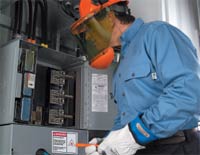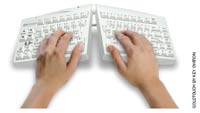
December 2008
- Preventing Industrial Fires
- Defibrillators & CPR: Why Don’t They Respond?
- Protective Apparel: Look Beyond the Arc Ratingks
- Signs & Signals: Keep Prevention in Mind
Click here to subscribe.
Cover Story
By Barry R. Weissman
Here it is December, and we’re talking about hot work. No, we aren’t talking about working when it’s hot—but, sometimes, we have to. We’re talking about working on equipment, making it hot, and having to be careful with the heat we generate and the surrounding environment.
Features
By Becca Kandler
Ideally, the workplace would be hazard-free and safe from potential injuries and accidents. However, many operations involve a certain amount of risk that cannot be controlled through engineering measures, administrative controls, or personal protective equipment. These situations require careful measures to prevent workplace accidents and injuries. The value of safety signs in these situations shouldn’t be ignored.
By Jerry Laws
AEDs are much improved since they began showing up in airports, arenas, and workplaces. Training is an essential part of getting workers to use them when necessary, and that training performs a valuable service in accurately educating the trainees about the latest guidelines for performing CPR, said Pam Erno, national account manager for the Health & Safety Institute.
By Jerry Laws
Because the sudden slide in U.S. stock prices was happening just as the OH&S 2008 Executive Safety Summit was taking place, managing in difficult times became a major theme for several presenters. Keynote speaker Robert Pater, managing director of Strategic Safety Associates Inc. and MoveSMART®, started the trend when he asked the audience to consider how stressful times affect people: They lose their sense of humor and develop tunnel vision.
By Alan McCartney
This article is an attempt to briefly cover the most common differences between types of sprinkler systems. Most sprinkler systems fall within one of four categories.
By Rob Brauch
Larry wakes up in the middle of the night with a prickly, tingling sensation in his hand. At first, he thinks nothing of it; maybe he slept in a bad position and his hand “went to sleep.”
By Rhonda Jessup
In its more than 30 years of existence, the Emergency Response Guidebook (ERG) has been the “go-to” reference for first responders faced with the possibility of a hazardous materials incident— and it will continue to be the essential reference. In order to reflect changes in both domestic and international regulations, the ERG is republished every four years in English, French, and Spanish.

By Rich Godjics
Understanding and protecting against arc flash and other electrical hazards and meeting the requirements of NFPA 70E has become more widely practiced in the past several years, and “8 cal” has become the industry standard for daily-wear FR clothing. This refers to the amount of protection from incident energy, expressed in calories per centimeter squared, that a fabric will provide in an arc flash exposure. It’s also expressed as an “ATPV” (Arc Thermal Performance Value) or arc rating.
Departments
By Linda J. Sherrard
2008 is coming to an end fast with many lessons learned this year, from natural disasters and financial disasters alike as the U.S. economy weakens. Maintaining a program and employees' interest during a struggling economy is challenging. It requires planning and thought to get your safety message to each employee in a timely and appropriate format to keep them focused on safety at work.
By
The U.S. Department of Labor’s Bureau of Labor Statistics reports that by the year 2010, 17 percent of the U.S. workforce will be 55 and older.
By Jerry Laws
I’ve learned a lot this year about patience, planning, risk taking, and managing. Poorer but wiser, I hope, after the financial markets' tumble, I am looking back on a year of growth and anxiety, with many successes and some disappointments.
By Robert Pater
Leaders know how important developing strategy is to setting the course. But if you aspire to highest levels of performance, you’ve got to go beyond just focused thinkiStrongest leaders know that real
By Marc Barrera
Firefighting is one of the world’s most dangerous and highly regarded jobs. As kids, many of us want to be firefighters when we grow up—but few of us actually do it. For Larry Wilson, his respect for the job was motivation enough not only to become a wildland firefighter while in college, but also to take it a step further and become a smokejumper.

By Ronnie Rittenberry
Try this: Stand up straight with your arms at your sides, palms facing legs. Slowly raise your arms from the elbow, letting your wrists relax. Now, without turning your wrists, start “typing.”